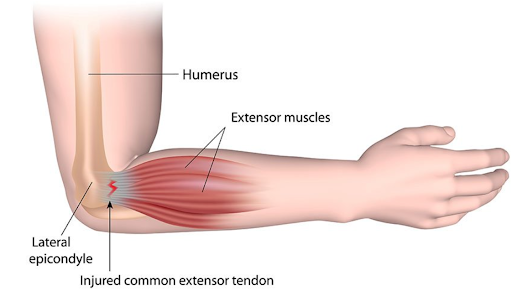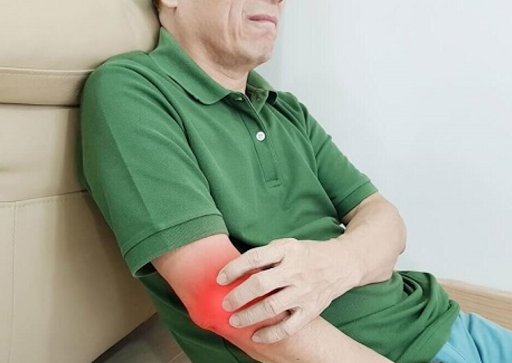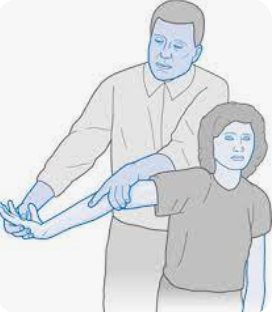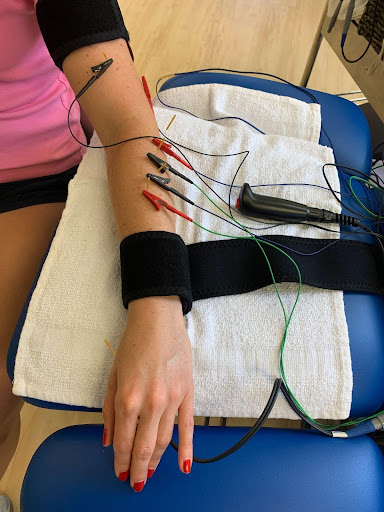Are you Suffering from Lateral Epicondylitis?
What is Lateral Epicondylitis?
Lateral epicondylitis, commonly known as tennis elbow, is a condition that causes pain and inflammation of the tendons that attach to the lateral epicondyle of the elbow. Despite its name, tennis elbow can occur in people who don’t play tennis. It is a repetitive strain injury that often affects individuals who engage in repetitive and forceful gripping or wrist extension activities.
The lateral epicondyle is a bony prominence or “bump” on the outer side of the elbow where the tendons of the forearm muscles attach. The condition develops as a result of overuse or repetitive stress on these tendons, leading to microtears and subsequent inflammation. Activities such as tennis, golf, painting, carpentry, typing, and repetitive computer mouse use can contribute to the development of tennis elbow.

How do I know if I have Lateral Epicondylitis?
Symptoms of tennis elbow may include pain and tenderness on the outer side of the elbow, which may radiate down the forearm. The pain is usually aggravated by activities that involve gripping or lifting. IT is common in movements that stress the wrist, such as turning a doorknob or shaking hands. Some individuals may experience weakness in the affected arm.

What does Physical Therapy treatment for Tennis Elbow look like?
Treatment for tennis elbow typically involves a combination of conservative measures aimed at reducing pain, promoting healing, improving strength and endurance of affected muscles and preventing further injury. These may include:
- Avoiding activities that exacerbate symptoms and allowing the affected tendons to rest and heal.
- Improving blood flow to the affected area via manual therapy techniques that assist in transporting healing factors to the affected tissues.
- Specific exercises and stretches that target these affected muscles and tendons can help strengthen the forearm muscles, improve flexibility, and promote healing.
Which Muscles Are Affected with Lateral Epicondylitis?
Lateral epicondylitis, or tennis elbow, primarily involves the tendons and muscles in the forearm. The main muscles involved in lateral epicondylitis are Extensor Carpi Radialis Brevis (ECRB), Extensor Carpi Radialis Longus (ECRL), Extensor Digitorum and Extensor Digiti Minimi. All these muscles form the common extensor tendon which attaches up at the elbow. That junction is where pain is located with someone suffering from lateral epicondylitis.
During activities that involve repetitive gripping, wrist extension, or repetitive stress on these muscles, the tendons that attach these muscles to the lateral epicondyle can become strained, leading to microtears and subsequent inflammation. This inflammation and damage to the tendons result in the symptoms associated with lateral epicondylitis.
How can Physical Therapy help with Lateral Epicondylitis?
Physical therapy plays a crucial role in the treatment of lateral epicondylitis. In fact, tennis elbow is common at our clinic in the Downtown Brickell area. Physical therapy will focus on promoting healing factors through a variety of different treatment strategies meant to speed up the healing process and prevent further compensation injuries or flare ups of the condition. Common strategies used in the treatment of tennis elbow are dry needling, soft tissue mobilization, eccentric wrist strengthening, stretching of tendons, and joint mobilizations if necessary. All treatment strategies are used on a case-by-case situation and selected appropriately after an in depth examination performed by your PT.

Therapy Techniques
- Manual Therapy: Manual therapy techniques, such as massage, joint mobilization, and soft tissue mobilization, can improve the flexibility and mobility of the affected area. These techniques can help reduce muscle tightness and improve blood flow to promote healing.
- One of the manual techniques that our physical therapists here at Symmetry are proficient in performing is called “Mill’s manipulation technique.”
- The Mill’s Manipulation technique has been shown to reduce pain significantly, increase grip strength and improve function.
- Addressing the proximal radioulnar joint, a significant joint related with Tennis Elbow, is part of the complete plan of care that needs to be included with the associate muscles.
- Stretching and Strengthening Exercises: Physical therapists can design specific stretching and strengthening exercises to target the affected muscles and tendons. These exercises aim to improve the flexibility and strength of the forearm muscles and reduce the strain on the tendons. Eccentric exercises, where the muscle lengthens while under tension, are often effective in treating lateral epicondylitis.
- Technique Modification: If the condition is caused by repetitive or improper movement patterns, physical therapists can analyze your technique in activities such as sports or repetitive work tasks. They can provide guidance on modifying your technique to avoid further stress on the affected tendons.
- Bracing or Taping: Physical therapists may recommend using a brace or taping techniques to provide support and stability to the affected area. This can help reduce strain on the tendons and promote healing.
- Education and Ergonomic Advice: Physical therapists can provide education on the condition, including advice on ergonomic modifications, proper body mechanics, and strategies to prevent further injury. They can also suggest modifications to your workspace or sports equipment to reduce stress on the affected tendons.
How Can Dry Needling Help with Tennis Elbow?

Dry needling is a technique that involves inserting thin needles into specific trigger points or tight bands of muscle to relieve pain and improve muscle function. However, it is used more than just for trigger points. Here’s how dry needling can help with lateral epicondylitis:
- Pain relief: Dry needling can help reduce pain associated with lateral epicondylitis. The insertion of needles into trigger points can stimulate the release of endorphins, which are natural pain-relieving chemicals in the body. This can provide temporary pain relief and improve comfort.
- Muscle relaxation: Dry needling can target tight or hypertonic muscles in the forearm and surrounding areas. By inserting needles into these muscles, it can help relax and release tension in the muscles. This may alleviate muscle imbalances and reduce strain on the tendons attached to the lateral epicondyle.
- Increased blood flow: The insertion of needles during dry needling can increase local blood flow to the affected area. Improved circulation can promote healing by delivering oxygen, nutrients, and immune cells to the injured tissues. This can help reduce inflammation and facilitate tissue repair.
- Improved muscle function: Dry needling may help restore normal muscle function by releasing trigger points and improving muscle flexibility. It can address muscle imbalances and dysfunction that may contribute to lateral epicondylitis, promoting optimal movement patterns and reducing strain on the tendons.
- Neurological effects: Dry needling may have neurological effects by stimulating sensory nerves and altering pain perception. This can help modulate pain signals and reduce pain sensitivity in individuals with lateral epicondylitis.
How Can WinBack TeCar Therapy Help with Tennis Elbow?
Winback TeCar Therapy uses radiofrequency current to increase the body’s natural healing process and decreases recovery time. Here’s how Winback TeCar therapy can help Tennis Elbow:
- Increased blood flow: To improve blood circulation to the affected area. Increased blood flow will help to deliver oxygen and nutrients to the affected tissues while removing waste products and facilitate the healing process.
- Pain reduction: Tecar therapy may help alleviate pain associated with tennis elbow. The heat generated by the therapy can enhance blood flow, improve muscle relaxation, and help to realign abnormal collagen fibers and scar tissue.
- Reduction of inflammation: Tennis elbow involves inflammation of the tendons. TeCar therapy may help to reduce inflammation and promote lymphatic drainage.
Can Other Body Parts Affect My Elbow?
While lateral epicondylitis primarily involves the forearm muscles and tendons, the shoulder and wrist can indirectly contribute to the development or exacerbation of this condition. The relationship between the shoulder, wrist and lateral epicondylitis is related to the kinetic chain and the interconnectedness of various body parts during movement.
- Compensation: If an individual has a shoulder injury or dysfunction, they may unconsciously alter their movement patterns to compensate for the shoulder issue. This compensation can put increased stress on the forearm muscles and tendons during activities that involve gripping or wrist extension, potentially leading to lateral epicondylitis.
- Poor biomechanics: Faulty shoulder mechanics, such as limited range of motion, weakness, or instability, can affect the overall movement of the upper limb. This can lead to altered movement patterns and increased stress on the forearm muscles and tendons, potentially contributing to the development of lateral epicondylitis.
- Overuse or repetitive strain: Certain occupations or sports activities that involve repetitive shoulder movements, such as overhead throwing or lifting, can put excessive strain on the shoulder and forearm muscles. Over time, this repetitive strain can contribute to the development of both shoulder issues and lateral epicondylitis.
Closing Thoughts
Lateral epicondylitis can significantly impact your daily life and physical abilities. However, with the help of physical therapy, you can reduce pain, improve mobility, and prevent future issues. By addressing the root causes, strengthening muscles, and promoting better movement, physical therapy plays a crucial role in managing lateral epicondylitis. If you suspect you have lateral epicondylitis, and are looking for a Physical Therapist, come see us at Symmetry Physical Therapy, located in Miami/Brickell downtown area, where we provide an in-depth assessment and treatment strategies so we can help you return to a pain free lifestyle.
Feel free to give us a call at (305) 331 2277 to schedule an appointment.
